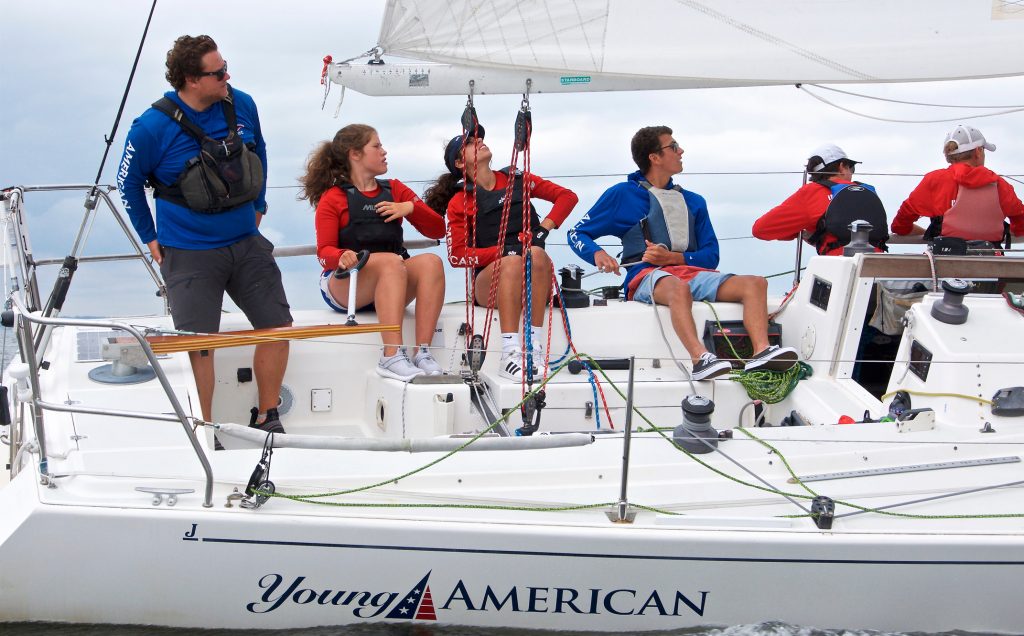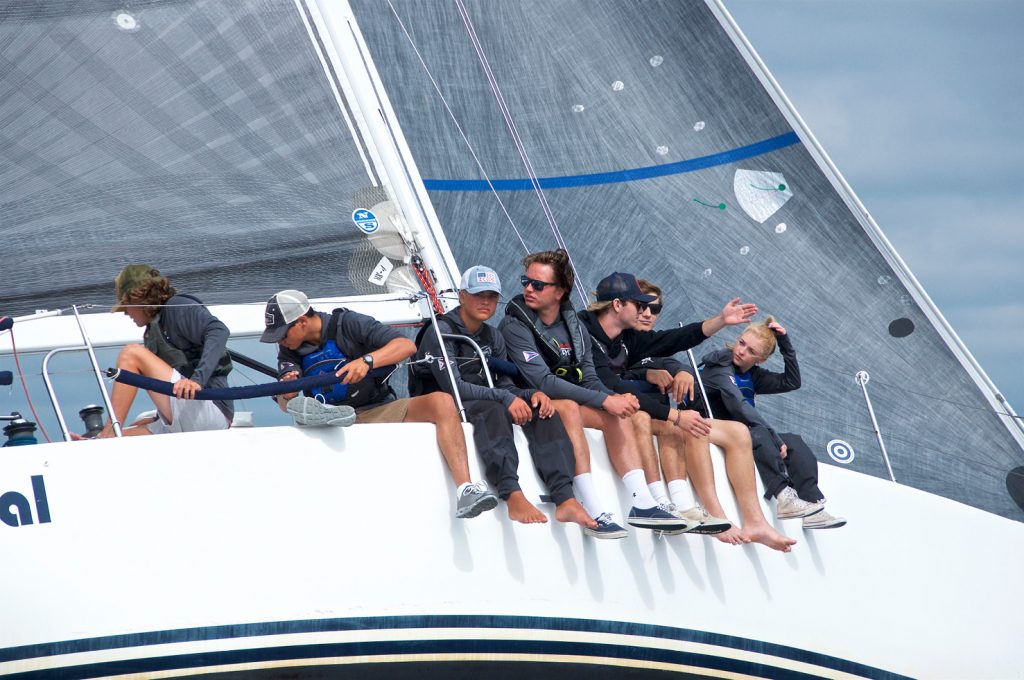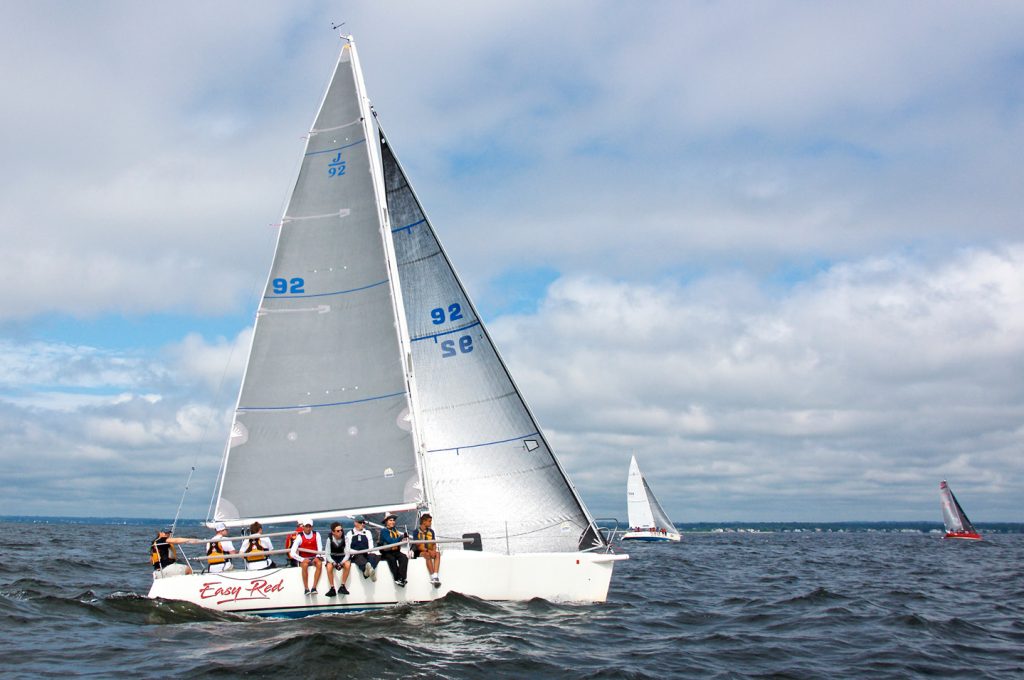Story & photos by Rick Bannerot
I’ve had the pleasure of photographing sailing on western Long Island Sound for 20+ years, ranging from Opti dinghies to Maxi yachts and just about everything in between. I am routinely gobsmacked by the growth of junior sailing, particularly juniors sailing on, and in fact actually sailing “big boats” ranging from keelboats like Sonars on the small side to 60-foot bluewater distance racers.
Adult racers and cruisers always seem to be moaning about the need to “attract more junior sailors.” Some of the old refrains go: “There aren’t enough young sailors in the pipeline,” and “How are we going to bridge the gap between Laser/420 sailing, kids going off to college, and then we don’t see ‘them’ until they are 35+ years old, married/with kids, and then they get the ‘itch’ to return to sailing?” and the classic line about letting kids sail big boats, “That is like tossing the keys to your Ferrari to a teenager!”
To those points, interest and participation in junior big boat sailing on the Sound certainly waxes and wanes with “enlightened” adults, pulses of enthusiastic club sailing directors, and the support of sailing clubs’ flag officers. Unfortunately, many supporters of junior big boat sailing move through their positions of influence and ability to commit club and personal resources in terms of staffing and finance in five- to eight-year timeframes. What is interesting is the cadre of future thinkers that are moving beyond the cyclical nature of junior big boat boosterism and putting long-term programs together.

Young American Sailing Academy racers have enjoyed considerable success in events on Long Island Sound and beyond. © Rick Bannerot/OntheFlyPhoto.net
What remain constant positive forces are the ever-present junior sailing association directors (like Bob Whittredge of the Junior Sailing Association of Long Island Sound) and their management of junior sailing activities. Safety-at-Sea seminars, such as those presented by US Sailing and the Storm Trysail Foundation are a critical component for imparting the vital knowledge and safety requirements that all sailors – not just juniors – need for any of the overnight, distance and bluewater races.

Representing Pequot Yacht Club, the crew of the J/109 Mistral prepares for a tack during the 54th Annual Regatta for the Dorade Trophy. © Rick Bannerot/OntheFlyPhoto.net
In an effort to bridge the gap between Laser/420 activities and the apparent “disappearance” of younger sailors on big boats, support for big boat offshore racing is also growing at the collegiate level.
In addition to the efforts of the Storm Trysail Foundation and their Intercollegiate Offshore Regatta (hosted annually by Larchmont Yacht Club), a growing number of college alumni are donating their boats to various organizations like the Young American Sailing Academy in Rye, NY, Oakcliff Sailing in Oyster Bay, NY, MudRatz in Stonington, CT, and service academies including the U.S. Merchant Marine Academy in Kings Point, NY, the U.S. Coast Guard Academy in New London, CT, the U.S. Military Academy at West Point, NY, and the U.S. Naval Academy in Annapolis, MD. Witness the number of “Corinthian” boats sailing in various “big boat regattas” up and down the East Coast.
Sure, kids have joined their parents on boats since the ancient Greeks and Vikings set sail. What I am specifically referring to are the programs that have come into existence since Peter Becker of American Yacht Club in Rye started putting AYC juniors on a donated J/105 known as “the green boat” in 2013. Peter helped update and overhaul the boat, and changed her livery to Young American. Then, based on interest from AYC juniors (and their parents), started what is now the 501(c)3 Young American Sailing Academy.
With the success of Young American and the junior sailors that rotated through the program, other clubs around the Sound took notice and participation in junior big boat racing started to increase at local events like the JSA of LIS’s Dorade Trophy and Beach Point Overnight race and in regional distance races like the Block Island Race, Stratford Shoals, and the bookends to the sailing season, Indian Harbor Yacht Club’s Geartester and Gearbuster.

Racers in the Indian Harbor Junior Big Boat Program sailed the J/92 Easy Red to victory in this year’s Dorade. © Rick Bannerot/OntheFlyPhoto.net
The first real “A-ha!” moment was when the then called “Young American Junior Big Boat Program” won Stamford Yacht Club’s prestigious Vineyard Race in 2013, and followed it up with the totally improbable and a “Who’d a thunk it?” experience of winning “line honors in the traditional boats” category of the 2016 Newport Bermuda Race aboard High Noon. The “kids” literally beat all the older sailors with their accrued hundreds of thousands of hours of bluewater racing experience. Of note, but not by accident or coincidence, the Young Americans had chartered High Noon, a USMMA-owned Tripp 41 which was donated by Heidi & Steve Benjamin.
In a similar vein, the MudRatz Offshore Team continues to make impressive showings with both their Swan 48 Dreamcatcher, as well as the new-to-the-fleet J/105 Mad Blue (as profiled in WindCheck; windcheckmagazine.com/article/mudratz_do_bermuda/ ). Dreamcatcher followed Young American’s success in the 51st Newport Bermuda Race in 2018, winning the Alfred E. Loomis Trophy in the super-competitive 14-boat Class 5 of the St. David’s Lighthouse Division.
For those paying attention, Peter Becker’s daughter Carina (one of the young sailors on the Vineyard Race podium in 2013) was back on the podium in the 2021 Vineyard Race as a crewmember of the Mills 68 Prospector, the overall winning boat. The congruence of smart minds and pooling of financial resources has clearly put some serious lift in the sails of “junior” big boat racing and the future looks bright if others are also willing to “toss a teenager the keys to a Ferrari.” ■
A longtime contributor of both stories and photographs to WindCheck, Rick Bannerot can usually be found photographing sailing events year-round on Long Island Sound, when not spending three times as long at the computer writing stories and editing pictures on his Apple MacBook Pro, which has replaced the dank photo darkrooms of his past. He can be reached through his photo website, OntheFlyPhoto.net.



